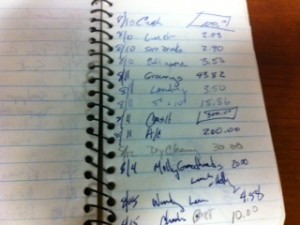When we were kids we had this funny phrase: “Runny Go”. It referred to the backing away from a hill and pedaling like crazy so you could maintain just enough momentum to get over the top. Starting at the bottom of a big hill from a dead stop, without a Runny Go, is torture. You have to stand up in the pedals and grind so slowly. If you let off at all, gravity pulls you back down the hill. Lots of things in life may require a Runny Go, including your first successful budget.
Instead of starting from a dead stop, spend a month building up some momentum. The goal is not to cut expenses – just record them. But if you feel the need to cut something, it is not against the rules.
Do a look back budget (time required 1-3 hours)
Set up your budget on paper or excel and do the last two-three months using your bank statements, credit card statements and memory, as best you can. Make a “don’t know” expense for the money you cannot account for.
Keep a journal (30 seconds for each purchase)
If you have expenditures you cannot account for, keep a little journal for the rest of the month – where you write down every dime you spend. It doesn’t need to be fancy, just scribble down what you spent the money on. Or, you can take a picture of every purchase as it happens.
Set aside 5 minutes every day
Spend 5 minutes updating your spreadsheet using your journal data
Mark the calendar
The expenses that destroy most budgets aren’t really unexpected; they just occur at irregular intervals. Pull out next month’s calendar and mark it up. Have company coming in? That will affect the food budget and maybe the entertainment budget too. Car insurance or tag renewal due? Write it down.
Armed and ready
As you approach the end of the month, you are getting ready to crest the hill. Gather all this new information and use it to make your budget for next month. Doing this prep work will make producing your first real budget much easier.


